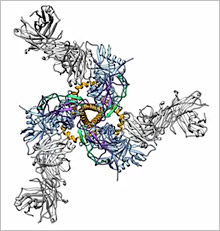Key HIV Protein Structure Revealed
Key HIV Protein Structure Revealed
Researchers have developed a more detailed picture of the protein largely responsible for enabling HIV to enter human immune cells and cause infection. The findings could help guide vaccine design.
HIV, the virus that causes AIDS, infects more than 34 million people worldwide. Once in the body, HIV attacks and destroys immune cells. Current treatment with antiretroviral therapy helps to prevent the virus from multiplying, thus protecting the immune system.
This model shows a birds-eye view of the trimeric structure of Env, a protein on the HIV surface that enables it to infect cells. Courtesy of the Scripps Research Institute.
Despite recent advances in treatment, scientists haven’t yet designed a vaccine that protects people from HIV. One challenge is that a viral surface protein known as Env can mutate rapidly. Resulting changes to the protein’s surface enable it to evade the immune system. An in-depth understanding of the structure of Env is critical to determine how the virus gains entry into cells. Env is also a major target for potential HIV vaccines.
Env extends from the surface of the HIV virus particle. The spike-shaped protein is “trimeric”—with 3 identical molecules, each with a cap-like region called glycoprotein 120 (gp120) and a stem called glycoprotein 41 (gp41) that anchors the structure in the viral membrane. Only the functional portions of Env remain constant, but these are generally hidden from the immune system by the molecule’s structure.
X-ray analyses and low-resolution electron microscopy have revealed the overall architecture and some critical features of Env. But higher resolution imaging of the overall protein structure has been elusive because of its complex, delicate structure. To gain a clearer image, a team of scientists at the Scripps Research Institute and Weill Cornell Medical College engineered a more sturdy form of the protein. Their work was supported in part by NIH’s National Institute of Allergy and Infectious Diseases (NIAID), National Institute of General Medical Sciences (NIGMS), and National Cancer Institute (NCI). The results were published in 2 papers online on October 31, 2013, in Science.
Using cryo-electron microscopy and X-ray crystallography, the researchers determined the detailed structure of Env. The team revealed the spatial arrangement of the Env components and their assembly. They determined the gp120 and gp41 subunit relationships as well as the interaction with neutralizing antibodies, which can block many strains of HIV from infecting human cells.
“Most of the prior structural studies of this envelope complex focused on individual subunits, but the structure of the intact trimeric complex was required to fully define the sites of vulnerability that could be targeted, for example with a vaccine,” says Scripps researcher Dr. Ian A. Wilson, a senior author of the papers.
“Now we all need to harness this new knowledge to design and test next-generation trimers and see if we can induce the broadly active neutralizing antibodies that an effective vaccine is going to need,” adds Weill Cornell scientist Dr. John P. Moore, another senior author.
By Harrison Wein, Ph.D.
###
* The above story is reprinted from materials provided by National Institutes of Health (NIH)
** The National Institutes of Health (NIH) , a part of the U.S. Department of Health and Human Services, is the nation’s medical research agency—making important discoveries that improve health and save lives. The National Institutes of Health is made up of 27 different components called Institutes and Centers. Each has its own specific research agenda. All but three of these components receive their funding directly from Congress, and administrate their own budgets.





















